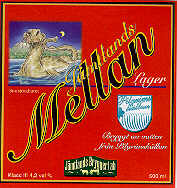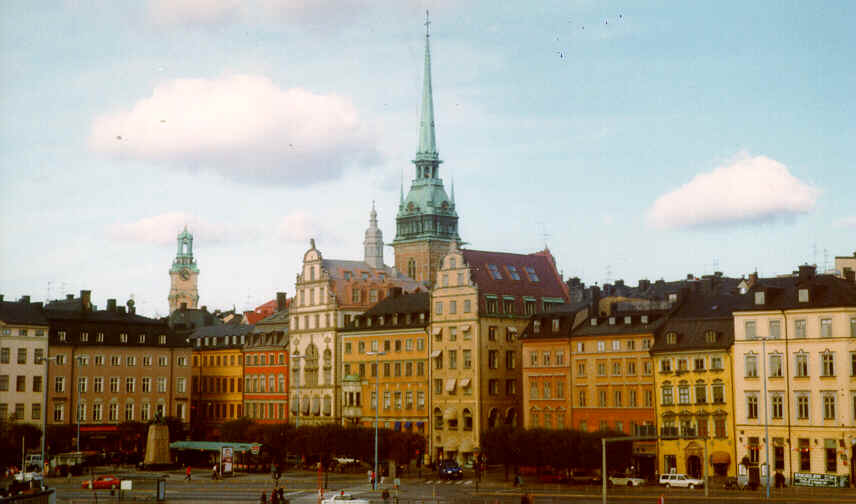
Before 1800
19th Century
1900 - 1950
1951 - 1977
1978 - 1990
Today
Swedish Beer Laws
Stockholm Pubs
Swedish Breweries
Gothenburg Pubs
Malmö Pubs
Since 1900 the Swedish brewing scene has been overshadowed by the anti-alcohol movement and various forms of state control. Both have restricted breweries room for manoeuvre and helped create the sad situation of the 1970s and 1980s, when Sweden had one of the most concentrated brewing industries in the world.
Things have improved since then, but there is still considerable pressure on Swedish brewing, especially from the temperance lobby. Any attempt at liberalising the strict controls on the sale of alcohol meets with stiff opposition. Sweden's admittance to the EU has proved helpful in changing some of the more ridiculous restrictions (like the ban on beer stronger than 5.6% alcohol) but the industry is still very tightly controlled. The future is likely to see further conflict between the EU and their liberalisation efforts and anti-alcohol groups.
From the Middle Ages until the 17th century beer was Sweden's national drink, but from 1700 onwards it rapidly lost popularity to spirits. Breweries had the exclusive right to distill and, given the large sums to be earned from spirits, had little incentive to develop the brewing side of their business. Unsurprisingly, the industry went into decline through lack of investment and failure to introduce new techniques.
Before the mid-19th century a wide range of styles were produced, some local, others imitations of German or even British styles. The 3 commonest local indigenous styles (or Svensköl) were dubbelt öl (double beer), enkelt öl (single beer) and svagöl (weak beer). All of these were top fermented.
The initial stimulus which helped beer to regain some of its popularity came from abroad. Porter was imported from Britain throughout the 18th century and in 1791 William Knox founded Sweden's first porter brewery in Göteborg.
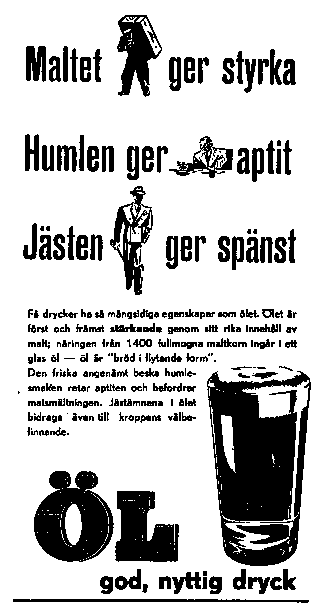 The most important development in the 19th century was the
introduction bottom-fermenting beer by Fredrik Rosenquist of Åkershult.
He had travelled through Germany, especially Bavaria, studying brewing methods
and on his return decided to have a go himself. He rented a small brewery
on Tullportsgatan in Södermalm in Stockholm and in late 1843 marketed Sweden's
first lager, a dark beer in the Münchener style.
The most important development in the 19th century was the
introduction bottom-fermenting beer by Fredrik Rosenquist of Åkershult.
He had travelled through Germany, especially Bavaria, studying brewing methods
and on his return decided to have a go himself. He rented a small brewery
on Tullportsgatan in Södermalm in Stockholm and in late 1843 marketed Sweden's
first lager, a dark beer in the Münchener style. Other breweries imitated Rosenquist's beer and soon a distinct Swedish lageröl style developed. This was pale brown or dark amber in colour - paler than the German original - and relatively lightly hopped, with an alcohol content of around 5.5%. Many Swedish breweries still make a Bayerskt in this approximate style, which is really a cross between a Münchener and a Vienna lager. Throughout the second half of last century this and porter were the standard beer types.
Pils was introduced in the 1870s. First, unsuccessfully, in 1876 by Alfred Sandwall in Borås. A year later, Franz Heiss, who had studied in Pilsen, started brewing a pilsener-bier at the Hamburgerbryggeriet in Luntmakeregatan in Stockholm. It was paler and much bitterer than the lageröl then being produced in Sweden. It was brewed to a gravity of 12% Plato and contained around 5% alcohol . There was some initial consumer resistance to the high levels of bitterness and, like pale ale in Britain, was first marketed amongst the middle classes. Gradually, the other breweries in Stockholm and then in the rest of Sweden began to brew pilsners of their own. By the end of the First World War it was the dominant style.
The number of breweries grew steadily through the second half of the century and reached its maximum in 1905 when there 240 in operation. Life was, however, about to start getting difficult again.
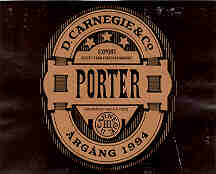 The new century witnessed a rapid growth in size and influence
of the temperance movement as a reaction to abuse of spirits. Unfortunately,
the the opponents to alcohol abuse also targeted beer and began to campaign
for total prohibition. This culminated in a referendum in 1922 on the banning
of all alcoholic drinks over 2.25%. A bitter campaign ended with a narrow
majority against prohibition (51% to 49%; 925,000 against, 889,000 for),
but the country was badly divided and the government very sensitive to the
temperance lobby.
The new century witnessed a rapid growth in size and influence
of the temperance movement as a reaction to abuse of spirits. Unfortunately,
the the opponents to alcohol abuse also targeted beer and began to campaign
for total prohibition. This culminated in a referendum in 1922 on the banning
of all alcoholic drinks over 2.25%. A bitter campaign ended with a narrow
majority against prohibition (51% to 49%; 925,000 against, 889,000 for),
but the country was badly divided and the government very sensitive to the
temperance lobby. In the first half of the century, the Svenska Bryggeriföreningen (the Swedish Brewers Association) strictly regulated competition. Breweries were effectively given local monopolies and were not allowed to sell outside a certain radius from the brewery. Prevented from expanding their sales by any other method, the only way to expand was by buying other breweries. As a consequence, by 1948 the number of breweries had fallen to 115, of which 16 brewery groups owned 66.
The new century witnessed a rapid growth in size and influence of the temperance movement as a reaction to abuse of spirits. Unfortunately, the the opponents to alcohol abuse also targeted beer and began to campaign for total prohibition. This culminated in a referendum in 1922 on the banning of all alcoholic drinks over 2.25%. A bitter campaign ended with a narrow majority against prohibition (51% to 49%; 925,000 against, 889,000 for), but the country was badly divided and the government very sensitive to the temperance lobby.
In the first half of the century, the Svenska Bryggeriföreningen (the Swedish Brewers Association) strictly regulated competition. Breweries were effectively given local monopolies and were not allowed to sell outside a certain radius from the brewery. Prevented from expanding their sales by any other method, the only way to expand was by buying other breweries. As a consequence, by 1948 the number of breweries had fallen to 115, of which 16 brewery groups owned 66.
The process of concentration was accelerated further when, in 1955, the system of regulation was abolished and breweries were allowed to sell their beer anywhere in the country. Small breweries, who had previously had been protected in their local markets, now faced competition from the larger concerns. The two largest, AB Stockholms Bryggerier and AB Pripps & Lyckholm, bought up and closed a whole string of breweries. In 1963 these two merged to create a giant concern of 35 plants which controlled 2/3 of the market. Plans were soon put into effect to concentrate production in three large breweries in Stockholm, Göteborg and Malmö. In 1974 the Swedish state took a controlling 60% stake in the company.
In 1965, in a rare outbreak of liberalism, a new class of beer, mellanöl, with a maximum alcohol content of 4.5% was allowed to be sold in ordinary shops. Previously, the strongest beer sold in food shops had been 3.6%, all more alcoholic drinks being only available in the Sytembolaget (state alcohol shop). The temperance movement reacted with a fierce attack on mellanöl, seeing it as the main cause of drunkenness and a corruptor of the young. After years of vigorous campaigning, they managed to get it banned in 1977.
| Beer classes 1965 - 1977 | |
| Class I: | 0.0 - 2.2% |
| Class IIA: | 2.3 - 3.6% |
| Class IIB: | 3.7 - 4.5% |
| Class III: | 4.6 - 5.6% |
The effect was the opposite of what the anti-alcohol lobby had expected. Rather than moving down to the weaker class II, drinkers switched to class III. As all beer between 3.5% and 5.6% was taxed at the same (very high) rate, producing and drinking beer at anything below the maximum allowed was an uneconomic proposition.
The number of breweries had continued to decline through the 1960s and was down to 25 (in 12 brewing groups) by 1977. Later in that year, there were fewer still, when Pripps bought Sandwalls and Falcon, which at that time the second and fifth biggest concerns, respectively. In 1980 Spendrups bought Risingbo Ångbryggeri AB and there were only 9 companies left in brewing.
The banning of mellanöl had reduced beer consumption by 25%. The industry was left with huge overcapacity and was thrown it into crisis. A government commission proposed rationalisation of the remaining breweries (with the exception of Pripps) into three regional groups. A state investment company, AB Brygginvest, was started with the intention of becoming part owner of the new regional groupings. It seemed as if the state was set to take control of the whole industry. In the early 1980s the government began to talk openly of merging Brygginvest and Pripps to create a single state entity controlling all beer production.
This plan was never carried out, partly due to opposition from some of the privately-owned breweries, partly due to changes in government and a move away from nationalisation. However, the industry continued to consolidate and by 1992 was down to 7 companies with just 10 breweries. The nadir had been reached.
Beer variety had been one of the victims of the incredible rationalisation of the 60s and 70s. The overwhelming majority of beer was in the international pils style, with bayerskt surviving as a speciality. Heavily processed, and with a high adjunct content, most beers gave the drinker little cause for excitement. The single exception being the one piece of beer culture even Pripps couldn't quite bring themselves to discard: Carnegie Porter. A thick, tasty stout in the Baltic style, it has managed to survive brewery closures, hostile laws (until 1955 starköl could only be obtained on prescription from a chemist) and the indifference of its owner.
The situation at the end of the 1980s could scarcely have been more depressing. One company with 2/3 of the market, masses of low-quality, taste-free lager and idiotic laws preventing most of the worlds best beers from being imported.
Just when the situation seemed irredeemably hopeless, the first green shoots of a revived beer culture began to pop up.
In 1988, the Sofiero brewery restarted production, using Sweden's last directly fired coppers. When enthusiasts decided to found a new brewery, Källefall, they caught the authorities unprepared. It had been so long since a one had been started that no-one knew what the procedure was.
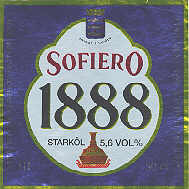 Throughout the early 1990s there was a trickle of new startups,
but the real boost came when Sweden joined the EU in 1995. On 1st January
1995 the ridiculous upper limit of 5.6% for beer was scrapped and for the
first time Swedes were able to buy the wonderful products of the worlds
richest beer culture, Belgium. The state monopoly on importing alcohol was
also scrapped and a new generation of traders went out in search of exciting
beers with which to tempt the country's drinkers.
Throughout the early 1990s there was a trickle of new startups,
but the real boost came when Sweden joined the EU in 1995. On 1st January
1995 the ridiculous upper limit of 5.6% for beer was scrapped and for the
first time Swedes were able to buy the wonderful products of the worlds
richest beer culture, Belgium. The state monopoly on importing alcohol was
also scrapped and a new generation of traders went out in search of exciting
beers with which to tempt the country's drinkers. The transformation could scarcely have been more dramatic. Sweden had changed from a sad beer desert into a country with a vibrant and varied beer culture, virtually overnight.
The increased interest in beer tempted many from the home brewing scene into setting up commercially. As in the USA, homebrewers brought an open-mindedness and an adventurous spirit into an industry usually noted for its conservatism. As a result, there has been an explosion in the number of styles produced and an immense broadening of the flavour spectrum. Where once there was only pale lager and slightly darker lager, now there are ales of all sorts, porters, pale ales, wheat beers, even a revival of an indigenous type, gotlandsdricke. Unfiltered lagers, or färsköl (fresh beer), have popped up to demonstrate how full-flavoured a bottom-fermented beer can be, if made properly.
There are currently around 40 breweries in operation, with more starting all the time, despite the considerable expense and bureaucracy involved. The microbrewery movement is still very young and immature, but should be able to find its feet in the coming years. Its only very recently that the law was changed to allow beer to be brewed and sold in the same premises. Consequently, Sweden had the honour of being the last country in Northern Europe to have a brewpub. There are now 3 (in Stockholm, Ystad and Bredaryd) and, judging by what has happened elsewhere, more are likely to follow.
The level of consumer knowledge has dramatically increased, though the stor stark (large strong - meaning a large class III beer, the indiscriminate way many Swedes would order in a pub: it didn't matter what sort of beer it was, as long as it was the maximum strength) mentality is not dead by any means. The Swedish beer consumers organisation, Svenska Ölfrämjandet, founded in 1985 can take much credit for raising the publics awareness. Many of the new commercial brewers are drawn from their ranks.
One oddity, is the presence of cask-conditioned beer. For some years a handful of pubs have sold imported British real ale. This has prompted some of the new micros to produce cask-conditioned beers of their own, though usually as special versions of their standard brands. Amazingly, Pripps have now and again produced a cask version of the revered Carnegie Porter.
Another sign of the renascent beer culture is the Stockholm Beer Festival. Held annually, it is the largest event of its kind in Scandinavia. It offers most of the indigenous brews, plus a large range of beers from all corners of the globe.
